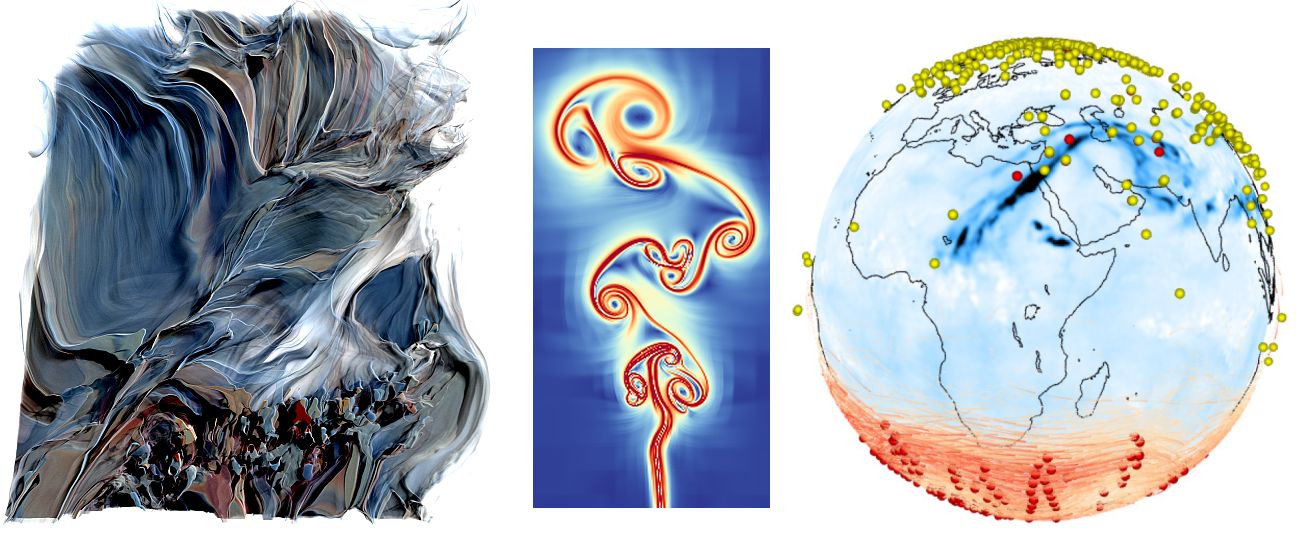Reiter

Description
The amount of data, generated in the pursuit of scientific discovery, keeps rapidly increasing across all major scientific disciplines. How can we make sense of large, time-dependent, high-dimensional and multi-variate data? This lecture provides an introduction into scientific visualization. Throughout the course, we cover the fundamental perception basics needed to convey information accurately. After categorizing different data types based on their dimensionality, we dive deeper into specific techniques for scalar, vector and tensor valued data.
Content
The lecture covers the following topics:
- visualization design basics (data abstraction, visual encoding of information),
- a review of scalar and vector calculus (differential properties, extremal and critical points),
- data structures and data acquisition techniques (grids, interpolation, and differentiation),
- indirect volume visualization (marching cubes and contour trees),
- direct volume visualization (ray marching and Monte Carlo rendering),
- elementary and line-based flow visualization (numerical integration, seeding, rendering),
- surface-based flow visualization (integration, selection, rendering),
- topology-based flow visualization (topological skeleton, bifurcations, feature flow fields),
- feature-based flow visualization (vortices, material boundaries, Lagrangian coherent structures),
- advanced methods (tensor visualization, uncertainty, ensembles)
Voluntary theoretical exercises concentrate on feature extraction from scalar and vector data, while voluntary programming exercises demonstrate the use of the Visualization Tool Kit, to implement interactive scientific data visualizations. This course is taught in English.
Grading
The course is concluded with an electronic exam in presence (90 minutes) at the end of the semester. The electronic exam is similar to the StudOn theory exercises. If 10 out of 18 points of the programming exercises are reached, then, as a bonus, the final grade will be improved by a third grade, i.e., by 0.3 or 0.4 grade points, respectively.
Goals and Competences
Students are able to:
- classify data and select appropriate visualization techniques
- calculate differential properties of scalar and vector fields
- identify features in scalar and vector-valued data
- implement numerical extraction algorithms
- learn the advantages and disadvantages of common visualization techniques
- use perceptual basics to select appropriate visualization methods
- explain and apply common interaction and data exploration paradigms
Live Stream & Lecture Recordings
The lectures are live-streamed and recorded, and are made available on FAU.tv. The theory exercises can be done on StudOn directly, making it possible to take the course fully virtually.
Registration
The course is open for registration in the weeks prior to the start of the summer semester. At any other time, you can send your IdM to ✉ tobias.guenther@fau.de and ask for admittance into the StudOn course.
Kategorien
Kurse
Scientific Visualization - SoSe 25
Vorlesung, SciVis, 2 SWS, Englisch
Do 16:15 - 17:45 c.t.
Tobias Günther
Sommer 2025: | | » campo
Um dieses Objekt zu nutzen, müssen Sie angemeldet sein und entsprechende Zugriffsrechte besitzen.
Tobias Günther
Sommer 2025: | | » campo
Um dieses Objekt zu nutzen, müssen Sie angemeldet sein und entsprechende Zugriffsrechte besitzen.
